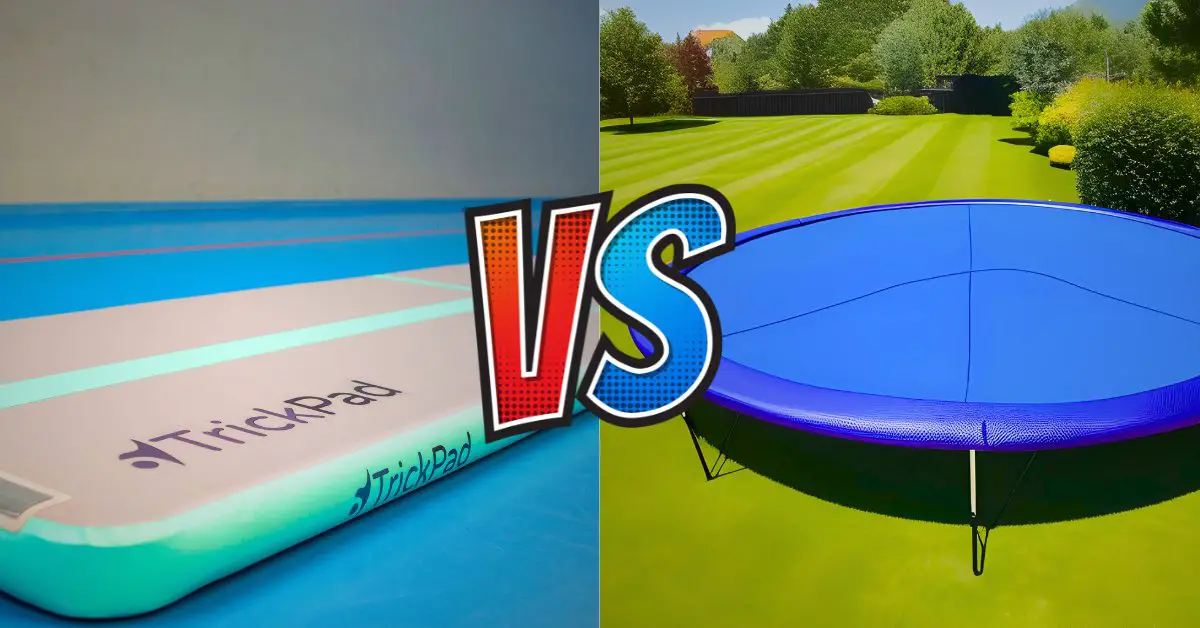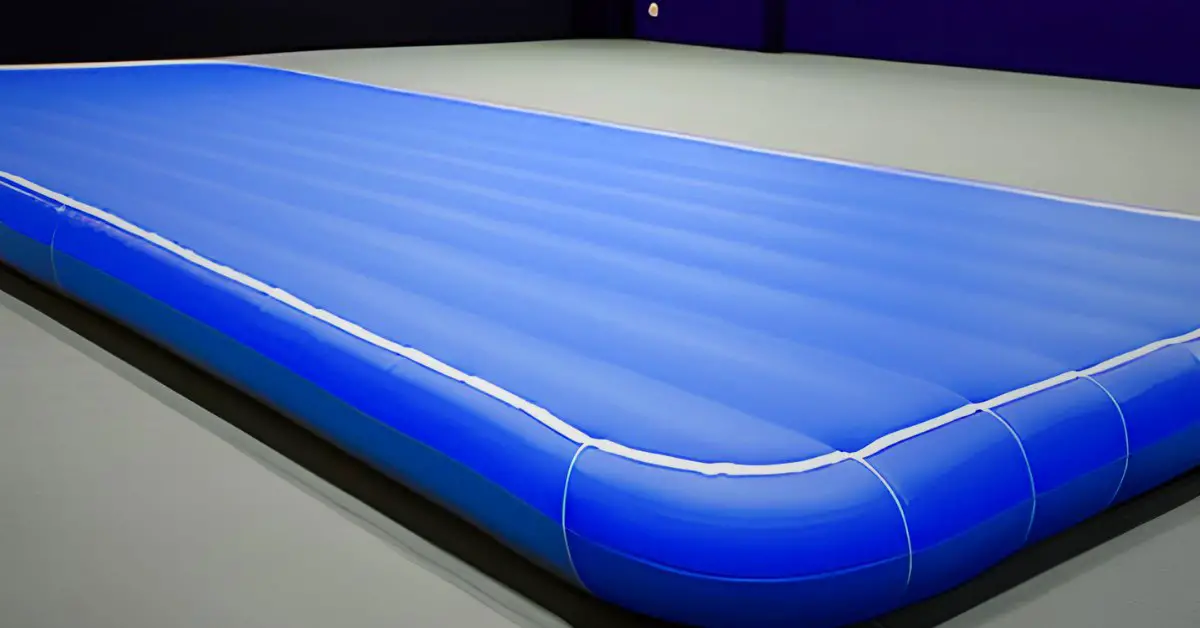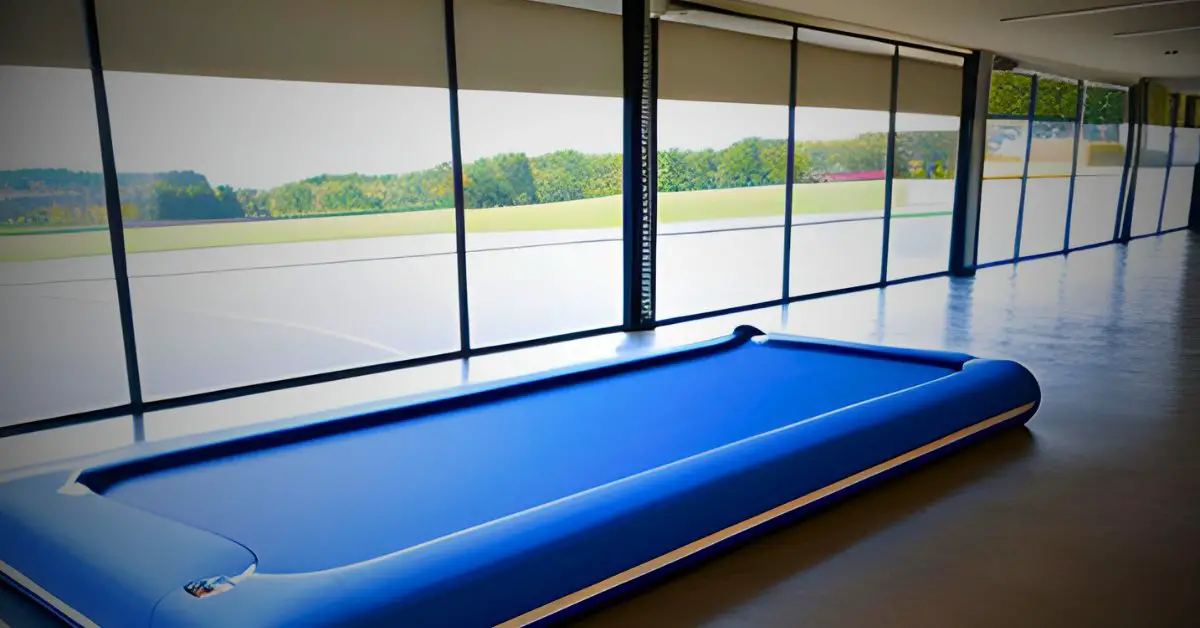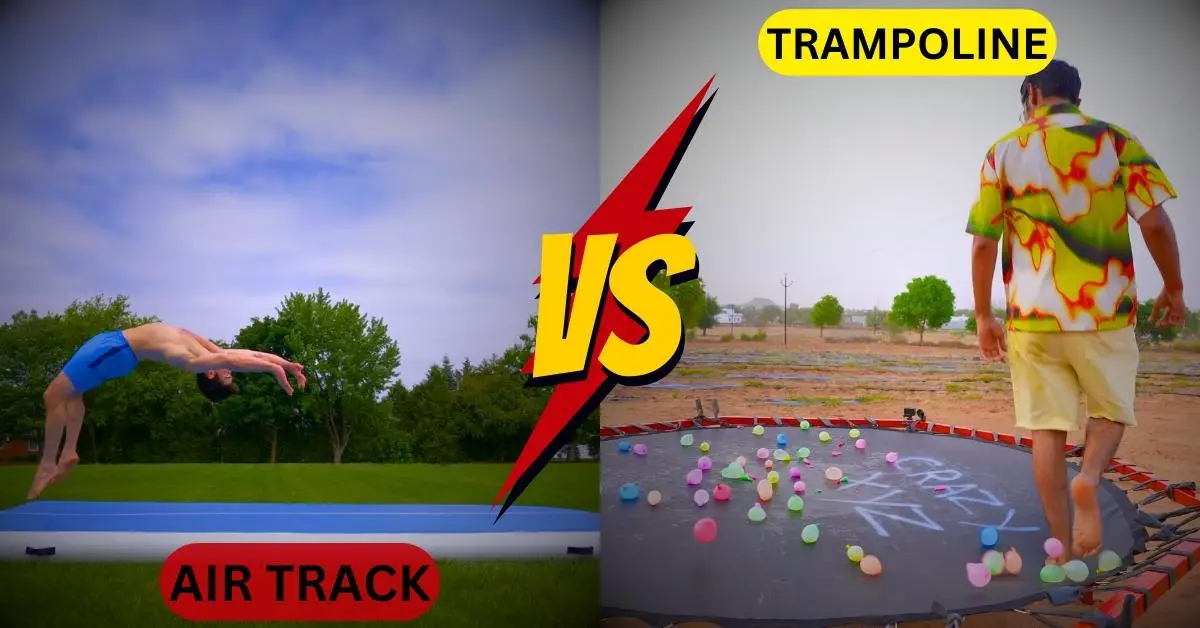Discover the ultimate showdown: Trampoline Vs Air Track. Which will bounce you higher, faster, and safer? Trampolines and air tracks are both popular equipment choices for individuals seeking to enhance their fitness routines or entertain themselves and others.
While they share some similarities in their function, such as providing a platform for jumping and acrobatics, there are notable differences between these two options.
In terms of design and construction, trampolines typically consist of a sturdy frame with coiled springs supporting a flexible fabric surface. On the other hand, air tracks utilize inflatable materials that provide a soft yet stable landing surface. These differences impact factors such as bounce height, shock absorption, and overall stability.
Safety features also vary between trampolines and air tracks. Trampolines often include safety nets or enclosures to prevent users from falling off the device, while air tracks rely on their low-profile design to minimize the risk of injury during use.
Additionally, portability and storage differ significantly between these two options. Trampolines require ample space for setup and are not easily transportable due to their size and weight. Conversely, air tracks are lightweight, inflatable, and can be conveniently deflated for storage or transportation.
Cost is another aspect to consider when comparing trampolines versus air tracks. Trampolines tend to be more expensive due to their complex construction materials and larger size. Air tracks generally offer a more affordable alternative without compromising functionality.
Before making a decision between these two options, individuals should carefully consider safety considerations such as user weight limits and recommended age ranges provided by manufacturers.
Furthermore, personal preferences regarding bounce intensity or fitness goals should be taken into account when choosing between trampoline or air track usage.
Overall, both trampolines and air tracks have unique advantages depending on individual needs and preferences. By thoroughly understanding the similarities as well as the differences in design, safety features, versatility, portability/storage convenience, cost implications, space requirements along with personal fitness goals, users can make an informed decision to select the most suitable option for their specific purposes.
Trampoline Vs Air Track: A trampoline is a springy surface used for bouncing, while an air track is an inflatable mat that provides a similar bouncing experience with added portability and safety benefits.
Similarities Between Trampoline Vs Air Track

Trampoline vs air tracks shares several similarities in terms of their design and functionality. Both trampolines and air tracks are designed to provide a safe and enjoyable experience for individuals engaging in various physical activities.
They both consist of a flexible surface that allows users to bounce or perform gymnastic maneuvers with ease.
One similarity between trampoline vs air tracks is the use of springs or air pressure to create a rebound effect. Trampolines utilize metal springs that are strategically placed along the frame, while air tracks rely on inflated chambers to generate the necessary bounce. These mechanisms enable users to achieve higher jumps, flips, and other acrobatic movements.
Another common feature between trampolines and air tracks is their emphasis on safety. Both equipment types are equipped with padding or cushions around their edges to prevent injuries caused by accidental falls or collisions with hard surfaces. Additionally, they promote proper body alignment during use, reducing the risk of strain or injury.
Furthermore, trampolines and air tracks offer versatility in terms of usage. They cater not only to professional athletes but also to recreational users seeking an entertaining way to stay active.
Whether it be for training purposes or pure enjoyment, these equipment options provide a wide range of possibilities for individuals looking to engage in physical activities.
Trampolines and air tracks exhibit numerous similarities concerning their design and functionality. Their shared characteristics include the incorporation of springs or pressurized chambers for enhanced rebound effects, prioritizing user safety through protective padding, as well as catering to various user needs ranging from professional training to recreational fun.
Differences in Design and Construction
In comparing trampoline vs air tracks, it is evident that there are distinct variations in their design and construction.
Trampolines typically consist of a metal frame with coiled springs attached to a fabric mat, allowing users to bounce and perform aerial maneuvers.
On the other hand, air tracks are inflatable mats made from durable materials such as PVC or drop stitch fabric, which provides a soft and bouncy surface for gymnastics or tumbling exercises.
One key difference in design lies in their portability. Trampolines are generally large and require a fixed installation outdoors or indoors. In contrast, air tracks offer greater convenience as they can be easily inflated or deflated, making them lightweight and portable. This feature allows users to use the air track at different locations without much effort.
Construction-wise, trampolines rely on the tension of springs to create bounce, while air tracks utilize pressurized air inside the inflatable mattress to provide a responsive surface.
The spring-based mechanism of trampolines may result in higher impact forces when landing compared to the softer landing provided by air tracks.
Overall, these differences in design and construction make trampolines suitable for recreational bouncing activities while air tracks cater more towards gymnastics training due to their portability and softer landing characteristics.
Understanding these variations helps individuals choose the equipment that best suits their specific needs.
Safety Features

Trampolines are equipped with safety nets and padding to minimize the risk of injuries. These safety features aim to prevent users from falling off the trampoline or landing on hard surfaces, reducing the likelihood of fractures or sprains.
In contrast, air tracks offer a softer landing surface that reduces the impact on joints, making them a safer option for activities involving jumping and tumbling.
Trampolines often have safety nets and padding to prevent injuries:
Safety nets and padding are commonly found on trampolines, aiming to minimize the risk of injuries. These safety features enhance the overall experience by providing a sense of security and peace of mind for users.
Here are five benefits of having safety nets and padding on trampolines:
- Protection from falls: Safety nets act as a barrier that prevents users from accidentally falling off the trampoline, reducing the likelihood of serious injuries.
- Soft landing surface: Padding around the trampoline’s edges creates a cushioning effect, minimizing the impact when landing and reducing the risk of sprains or fractures.
- Preventing entanglement: The netting material used in safety nets is designed to prevent fingers or limbs from getting caught in between springs or support poles.
- Enhanced stability: The presence of safety nets and padding improves stability, allowing users to jump confidently without worrying about losing balance or tripping over.
- Peaceful playtime: With these safety features in place, parents can have peace of mind knowing that their children can enjoy bouncing on a trampoline safely.
By prioritizing customer safety through these added precautions, trampolines with safety nets and padding provide an enjoyable experience while ensuring user well-being.
Air Tracks have a Lower Impact on Joints and Provide a Softer Landing Surface:
Air tracks offer a significantly gentler impact on joints and create a more forgiving surface for landings. This is particularly beneficial for individuals who engage in activities involving jumping and landing, such as gymnastics or acrobatics. The softness of the air track reduces the stress placed on joints, minimizing the risk of injury.
Additionally, it provides a cushioned surface that absorbs the impact of landings, further protecting the body from potential harm. This feature makes air tracks an ideal choice for those seeking to minimize joint strain and maximize safety during physical activities.
Furthermore, by offering a softer landing surface, air tracks contribute to enhanced comfort and overall well-being while performing various exercises or routines.
Overall, the use of air tracks promotes joint health and ensures safer landings during high-impact movements, serving individuals’ desire for injury prevention and physical support.
Versatility
Versatile equipment options offer a range of training possibilities, appealing to individuals looking for an all-encompassing fitness experience. When it comes to versatility, both trampolines and air tracks have their unique advantages.
Trampolines are known for their ability to provide a high-flying experience, allowing users to perform various acrobatic movements such as flips and twists. This makes them ideal for individuals interested in improving their aerial skills or participating in sports like gymnastics or cheerleading.
On the other hand, air tracks also offer a considerable level of versatility. These inflatable mats can be easily adjusted to different levels of firmness, providing varying degrees of rebound and support. This allows users to modify the intensity of their workout based on their preferences and fitness goals.
Additionally, air tracks are highly portable and can be used both indoors and outdoors, making them suitable for individuals who enjoy working out in different environments.
Furthermore, air tracks can be used in combination with other exercise equipment such as resistance bands or weights to create a more challenging workout routine. They can also serve as a cushioned surface for practicing yoga or Pilates exercises that require balance and stability.
Both trampolines and air tracks offer versatile training options that cater to individuals seeking diverse fitness experiences. While trampolines excel in providing an exhilarating aerial workout, air tracks offer adjustable firmness levels and portability for added convenience during exercise sessions.
Ultimately, the choice between the two depends on personal preferences and specific fitness goals.
Portability and Storage
Portability and storage are important factors to consider when choosing fitness equipment that can easily be transported and stored in various environments. These aspects play a crucial role in determining the practicality and convenience of the equipment.
When comparing trampoline vs air tracks, it is evident that both options offer different levels of portability and storage capabilities.
Trampolines, being larger and bulkier, may pose challenges in terms of transportation and storage. Their size makes them less portable as they require more effort to move from one location to another.
In addition, trampolines usually need ample space for assembly, which may limit their usability in smaller areas or indoor settings with limited ceiling height.
On the other hand, air tracks provide superior portability due to their inflatable nature. They can be easily deflated, rolled up, and packed into a compact bag or container for transportation.
This makes them ideal for individuals who travel frequently or need to transport their fitness equipment between different locations.
In terms of storage, trampolines often require dedicated outdoor spaces due to their size and inability to be easily disassembled. Air tracks, on the other hand, can be deflated and stored in smaller spaces such as closets or under beds when not in use.
Considering the importance of portability and storage for individuals seeking versatile fitness equipment that serves others’ needs effectively, air tracks emerge as a more convenient option compared to trampolines.
Maintenance and Durability
Maintenance and durability are crucial aspects to consider when evaluating the performance and longevity of fitness equipment. For individuals seeking equipment that serves others, it is important to examine the maintenance requirements and durability of trampolines and air tracks.
In terms of maintenance, trampolines generally require more upkeep compared to air tracks. Trampoline frames may need regular inspections for rust or corrosion, while springs may need replacement over time due to wear and tear.
Additionally, the jumping mat on a trampoline needs to be cleaned regularly to remove dirt and debris that can accumulate during use.
On the other hand, air tracks typically have a simpler design with fewer components that require maintenance. They often only require occasional cleaning and inspection for any signs of damage.
When considering durability, both trampolines and air tracks have their advantages. Trampolines are typically made with sturdy metal frames and springs that can withstand heavy use over time. However, they may be more susceptible to wear and tear due to exposure to outdoor elements such as sun, rain, or snow.
Air tracks are usually constructed with durable materials like PVC or drop stitch fabric that can withstand frequent bouncing without losing shape or integrity. They also tend to be more resistant to weather conditions since they can be used indoors.
Overall, individuals seeking fitness equipment that requires minimal maintenance and offers long-lasting durability may find air tracks more suitable compared to trampolines.
However, it is essential for users to follow proper care instructions provided by manufacturers in order to ensure maximum safety and longevity of either option.
Cost
When evaluating fitness equipment, it is important to consider the financial aspect, specifically the cost of investing in such equipment. When comparing trampoline vs air tracks, cost plays a significant role in decision-making. Here are four key points to consider:
- Initial Investment: Trampolines generally have a higher upfront cost compared to air tracks. This is because trampolines require a sturdy frame and springs for support, whereas air tracks are inflatable and do not require additional components.
- Maintenance Expenses: Trampolines often require regular maintenance to ensure safety and longevity. This includes checking springs, replacing mats or pads, and inspecting the frame for any damage. In contrast, air tracks have minimal maintenance needs since they are made of durable materials that can withstand frequent use.
- Repair Costs: In case of damage or wear over time, trampoline repairs can be costly due to the complexity of its structure. On the other hand, repairing an air track usually involves simple patching or replacing individual sections at a lower expense.
- Long-term Value: While trampolines may have higher initial costs and maintenance expenses, they tend to have longer lifespans compared to air tracks. Therefore, if long-term durability is prioritized over immediate savings, investing in a trampoline might be more beneficial.
Considering these factors will help individuals make an informed decision based on their budgetary constraints and long-term goals when choosing between a trampoline or an air track for their fitness needs.
Safety Considerations
Trampolines pose a greater risk of injuries, particularly when used improperly or without supervision. This is due to the inherent unpredictability and potential for falls or collisions with hard surfaces.
In contrast, air tracks offer a safer and more controlled environment for practicing gymnastics or aerial skills, minimizing the risk of serious injuries associated with trampoline use.
Trampolines have a higher risk of injuries, especially if not used properly or without supervision
Despite the allure of soaring through the air with exhilarating jumps, it is important to recognize that trampolines pose a heightened risk of injury, particularly when utilized improperly or without proper supervision.
Trampolines have been associated with various types of injuries, including sprains, fractures, and head injuries. In fact, studies have shown that trampoline-related injuries are more common in children and adolescents compared to adults.
One reason for this increased risk is the potential for collisions or falls off the trampoline surface. Additionally, inexperienced users may attempt high-risk maneuvers or land awkwardly, increasing their chances of getting hurt. To illustrate the risks involved with trampoline use, consider the following table:
| Type of Injury | Potential Consequences |
|---|---|
| Sprains | Pain and limited mobility |
| Fractures | Bone damage requiring medical intervention |
| Head Injuries | Concussions or other traumatic brain injuries |
In light of these safety concerns, it is crucial to emphasize proper usage guidelines and adult supervision when engaging in trampoline activities.
Air tracks provide a safer and more controlled environment for practicing gymnastics or aerial skills
Air tracks offer a controlled and secure environment for practicing gymnastics or aerial skills, providing a stable and supportive surface that minimizes the risk of injuries.
These inflatable tracks are made from durable materials that absorb impact and reduce the force exerted on the body during jumps, flips, or tumbles.
The air-filled structure allows for customizable firmness, accommodating different skill levels and preferences. Additionally, air tracks provide a uniform surface with consistent bounce throughout, ensuring predictable movements and reducing the chance of unexpected falls.
This controlled environment promotes confidence and encourages athletes to push their boundaries safely.
Furthermore, air tracks are designed to be wider than traditional trampolines, allowing for more space to perform routines without fear of colliding with surrounding structures. This not only enhances safety but also enables athletes to explore more complex movements freely.
Overall, by offering a safer alternative to trampolines, air tracks contribute to creating an environment where individuals can develop their gymnastic or aerial skills confidently while minimizing the risk of injuries.
Space Requirements

Trampolines typically require a significant amount of outdoor space and may not be suitable for indoor use due to their size and potential impact on surrounding objects.
In contrast, air tracks are versatile in terms of their usage as they can be utilized both indoors and outdoors.
Additionally, air tracks offer the advantage of being adjustable to different sizes and shapes, providing flexibility in training or recreational activities.
Trampolines require a large outdoor space and may not be suitable for indoor use
One limitation to consider when using trampolines is the need for a spacious outdoor area, which may make them unsuitable for indoor use. Trampolines generally require a large open space due to their size and height. This is because when bouncing on a trampoline, users can reach significant heights and perform various acrobatic movements.
Moreover, trampolines need clearance around them to ensure the safety of the user and prevent any potential collisions with objects or structures nearby. Therefore, individuals who lack access to ample outdoor space might find it challenging to accommodate a trampoline safely.
Furthermore, indoor spaces typically have limited ceiling height and restricted room dimensions that may not be conducive to safe jumping on a trampoline. As such, alternative options like air tracks that offer similar benefits but require less space could be more suitable in these situations.
Air tracks can be used both indoors and outdoors, and can be adjusted to different sizes and shapes
A notable advantage of air tracks is their versatility in terms of location and adaptability to different dimensions and shapes. Unlike trampolines, which require a large outdoor space, air tracks can be used both indoors and outdoors, making them suitable for various environments.
This is particularly beneficial for individuals or organizations that may not have access to a spacious outdoor area.
Additionally, air tracks can be easily adjusted to different sizes and shapes, allowing users to customize their experience based on their specific needs. Whether it is for gymnastics training or recreational purposes, the ability to modify the dimensions and shape of an air track offers flexibility and convenience.
This adaptability enhances the overall user experience by providing options that cater to individual preferences and requirements.
Personal Preferences and Fitness Goals
Preferential inclinations and individual aspirations towards physical well-being can be discerned by selecting between trampolines and air tracks as fitness equipment. Both trampolines and air tracks offer unique benefits that cater to different personal preferences and fitness goals.
- Versatility: Air tracks provide a versatile platform for various exercises, including tumbling, gymnastics, and cheerleading routines. They can be adjusted to different sizes and shapes, allowing individuals to customize their workout experience according to their specific needs.
- Safety: Trampolines are equipped with safety features such as nets or enclosures that prevent users from falling off the equipment during intense physical activities. This feature appeals to individuals who prioritize safety in their fitness routines.
- Portability: Air tracks are lightweight and portable, making them suitable for both indoor and outdoor use. This characteristic is particularly appealing to those who seek convenience in their exercise regimen, enabling them to practice anytime and anywhere.
By considering these factors, individuals can make an informed decision based on their own preferences and fitness goals. Whether one seeks versatility in training options or prioritizes safety measures during workouts, both trampolines and air tracks offer unique advantages that contribute to overall physical well-being.
Ultimately, the choice between trampoline or air track depends on the personal inclination towards specific exercises and the desire for serving others through physical wellness activities.
Maintenance and Safety
Maintaining and ensuring safety is paramount when using trampolines and air tracks. To keep your trampoline in good condition, conduct regular inspections for any signs of wear or damage in the frame, springs, and mat.
Tighten loose bolts and replace worn-out parts promptly. Store the trampoline indoors or cover it during bad weather to prevent damage. Keep the trampoline clean and free from debris to avoid hazards.
Similarly, for the air track, check for leaks before each use and promptly repair any minor damages. Store it in a dry area, away from sharp objects. Supervise users, especially children, on both equipment at all times, and educate them on safe jumping techniques.
Avoid overcrowding and prohibit risky stunts. Follow weight and user limits specified by the manufacturer. Implement proper safety gear, such as enclosures for trampolines and crash mats for air tracks.
Warm up before using the equipment, and avoid pushing beyond your skill level. Be prepared for emergencies with a first aid kit and emergency contact information. Promote safety awareness within the community to ensure an enjoyable and injury-free experience with trampolines and air tracks.
Frequently Asked Questions:
Q:1 Can I use a trampoline or an air track for gymnastics and other high-impact activities?
Both trampolines and air tracks can be used for gymnastics and high-impact activities. They provide a safe and cushioned surface that reduces the risk of injuries. However, it is essential to consider individual preferences, training goals, and specific requirements when choosing between the two.
Q:2 Are trampolines and air tracks suitable for indoor and outdoor use?
Trampoline vs air tracks can be used both indoors and outdoors, providing suitable surfaces for high-impact activities. They offer versatility in terms of location, allowing individuals to engage in gymnastics and other activities in various settings.
Q:3 How often do trampolines and air tracks need to be inspected or maintained?
Trampolines and air tracks should be regularly inspected and maintained to ensure safety. Regular inspections can help identify any damage or wear that may require immediate attention, reducing the risk of accidents and prolonging their lifespan.
Q:4 Can trampolines and air tracks be easily stored or transported when not in use?
Trampolines and air tracks can be easily stored or transported when not in use. They are designed to be lightweight and compact, making them convenient for storage in small spaces or transportation to different locations.
Q:5 What are some important factors to consider when choosing between a trampoline and an air track for personal fitness goals?
Important factors to consider when choosing between a trampoline and an air track for personal fitness goals include safety, durability, versatility, space requirements, skill level needed, cost, and the specific fitness goals one wants to achieve.
Conclusion:
In conclusion, trampoline vs air tracks share some similarities in terms of providing a bouncy surface for recreational activities. However, they differ significantly in their design, construction, safety features, versatility, portability, storage requirements, cost, space requirements, and suitability for different fitness goals.
When considering which option to choose, individuals should carefully assess these factors and prioritize their personal preferences and specific fitness objectives.
Overall, both trampolines and air tracks offer unique benefits and considerations that individuals should evaluate before making a decision.
We hope you will be well aware of trampoline vs air track, after reading this comprehensive article. If you have any questions, feel free to comment below!

